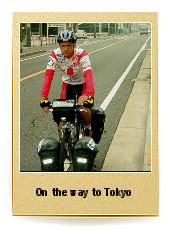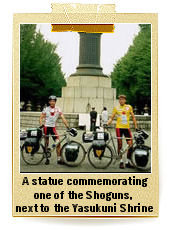In Tokyo
The flight was very tiring, and I could not fall asleep. After nine and a half hours we arrived at Narita airport, around 60 km from the centre of Tokyo. We were surprised during passport control – the Japanese would not let us in even though they should have. "What's wrong? - I asked – we do have visas". The customs officer replied in broken English that we had not submitted information about our overnight accommodation. How was I supposed to know where we would stay overnight? If I had known it was so important, I would have written some address down. I tried to explain that we were on a cycling expedition, etc, but I could see the guy was not going to make it easy. He demanded a detailed itinerary and God only knows what else. Finally he told us to show how much cash we had. I waved a wad of 100 dollar bills in front of his face and he gave up immediately. The whole incident lasted more than half an hour.
On leaving the airport we got quite shocked. How to get to Tokyo when all signs are in Japanese (Kanji characters) and – what was even worse – there was left-hand traffic. Initially we preferred cycling on the sidewalks. First we cycled around Narita and then went back to the airport to buy a decent road map of Japan, and a Tokyo city map. Finally we set off for Tokyo, but after 25 km we had to find shelter from the rain. Some spot under a bridge seemed perfect. As soon as I sat down, I rested my head on the knees and fell asleep. The sleepless night took its toll. The rain did not subside until the next morning, so that night we set up a camp under the bridge. While I was sound asleep – being used to sleeping in the most bizarre places during previous expeditions – Sławek did not feel comfortable. It wasn't surprising, bearing in mind that at the break of dawn we were woken by a terrible noise. Some Japanese driver fell asleep behind the wheel and hit a bridge barrier. It was exactly the same bridge where we slept. Next morning we cycled towards Tokyo.
 The road mostly ran through an immense, limitless city. The traffic was terrible. On top of it all, it started to rain. We got lost trying to find the way to the centre. It was difficult to communicate with the Japanese, as most of them could not speak English. Finally we got to Ginza, the famous district of Tokyo. With thousands of flickering neon signs, it got particularly attractive at night.
The road mostly ran through an immense, limitless city. The traffic was terrible. On top of it all, it started to rain. We got lost trying to find the way to the centre. It was difficult to communicate with the Japanese, as most of them could not speak English. Finally we got to Ginza, the famous district of Tokyo. With thousands of flickering neon signs, it got particularly attractive at night.
As it was getting dark already, we headed for the long-yearned-for youth hostel, where we intended to take a shower and go to sleep. However, when we finally reached the spot – after a long search – we were told there were no free rooms. The hostel manager was very brusque with us. He did not care at all that we had no idea what to do. We were truly perplexed, but we noticed a bath house nearby. In fact, it was a part of a sizeable hotel and sports complex. We mixed with the crowd of hotel guests, and successfully washed ourselves. As it turned out, finding cheap lodging in Tokyo was quite a challenge. Nobody could recommend any budget inns or guesthouses. We didn't even get any useful tips at a police station. Staying overnight at the other youth hostel we had heard of was out of the question, as the facility was situated at the fourteenth floor of a skyscraper. Going all the way up with our luggage would have been very troublesome. I decided that we would choose our tried and tested solution – sleeping in a park. We set up a tent in a shaded place, in the well known Yoyogi Park. I cannot say I slept soundly this time. I was distracted by millions (literally!) of blue desert crickets (nice name, isn't it?) embroiled in fierce disputes. Early in the morning some kind of ravens joined this "choir", cawing so loudly that I could not get back to sleep. At around 7 am I stuck my head out of the tent, and what did I see? A few Japanese jogging around with stony faces, pretending not to see us. In a similar vein (although rushing a bit), we took down the tent as if nothing had happened.
Leaving the park, we decided that we had had enough of Tokyo and that we should leave this noisy and smoggy place. On our way we stopped by the Yasukuni Shinto shrine devoted to deities of war, and commemorating the military dead, including Kamikaze pilots.
It is worth adding that Shinto is an old Japanese religion with the highest number of adherents (Buddhism is ranked second). It is a pagan religion worshipping nature and numerous deities.
On leaving the airport we got quite shocked. How to get to Tokyo when all signs are in Japanese (Kanji characters) and – what was even worse – there was left-hand traffic. Initially we preferred cycling on the sidewalks. First we cycled around Narita and then went back to the airport to buy a decent road map of Japan, and a Tokyo city map. Finally we set off for Tokyo, but after 25 km we had to find shelter from the rain. Some spot under a bridge seemed perfect. As soon as I sat down, I rested my head on the knees and fell asleep. The sleepless night took its toll. The rain did not subside until the next morning, so that night we set up a camp under the bridge. While I was sound asleep – being used to sleeping in the most bizarre places during previous expeditions – Sławek did not feel comfortable. It wasn't surprising, bearing in mind that at the break of dawn we were woken by a terrible noise. Some Japanese driver fell asleep behind the wheel and hit a bridge barrier. It was exactly the same bridge where we slept. Next morning we cycled towards Tokyo.
 The road mostly ran through an immense, limitless city. The traffic was terrible. On top of it all, it started to rain. We got lost trying to find the way to the centre. It was difficult to communicate with the Japanese, as most of them could not speak English. Finally we got to Ginza, the famous district of Tokyo. With thousands of flickering neon signs, it got particularly attractive at night.
The road mostly ran through an immense, limitless city. The traffic was terrible. On top of it all, it started to rain. We got lost trying to find the way to the centre. It was difficult to communicate with the Japanese, as most of them could not speak English. Finally we got to Ginza, the famous district of Tokyo. With thousands of flickering neon signs, it got particularly attractive at night. As it was getting dark already, we headed for the long-yearned-for youth hostel, where we intended to take a shower and go to sleep. However, when we finally reached the spot – after a long search – we were told there were no free rooms. The hostel manager was very brusque with us. He did not care at all that we had no idea what to do. We were truly perplexed, but we noticed a bath house nearby. In fact, it was a part of a sizeable hotel and sports complex. We mixed with the crowd of hotel guests, and successfully washed ourselves. As it turned out, finding cheap lodging in Tokyo was quite a challenge. Nobody could recommend any budget inns or guesthouses. We didn't even get any useful tips at a police station. Staying overnight at the other youth hostel we had heard of was out of the question, as the facility was situated at the fourteenth floor of a skyscraper. Going all the way up with our luggage would have been very troublesome. I decided that we would choose our tried and tested solution – sleeping in a park. We set up a tent in a shaded place, in the well known Yoyogi Park. I cannot say I slept soundly this time. I was distracted by millions (literally!) of blue desert crickets (nice name, isn't it?) embroiled in fierce disputes. Early in the morning some kind of ravens joined this "choir", cawing so loudly that I could not get back to sleep. At around 7 am I stuck my head out of the tent, and what did I see? A few Japanese jogging around with stony faces, pretending not to see us. In a similar vein (although rushing a bit), we took down the tent as if nothing had happened.

Leaving the park, we decided that we had had enough of Tokyo and that we should leave this noisy and smoggy place. On our way we stopped by the Yasukuni Shinto shrine devoted to deities of war, and commemorating the military dead, including Kamikaze pilots.
It is worth adding that Shinto is an old Japanese religion with the highest number of adherents (Buddhism is ranked second). It is a pagan religion worshipping nature and numerous deities.



